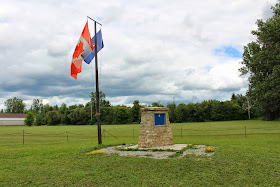I found the following article that tells some of the story of the base, which is almost gone, and the memorial that now stands there.
The article is from the Historic Gloucester Quarterly Newsletter of the Gloucester Historical Society
and The Gloucester Museum and Archives, Volume 6 No. 2 Fall 2005
HMCS Gloucester
By Mary Boyd
Over the past year or so, a group of retired Chiefs and Petty Officers (Pos) of the old Communicator (S) Branch have been doing the preparatory legwork for a project to preserve the memory of HMCS Gloucester. The intention was to install a cairn with a commemorative plaque at the former entrance road to the base.
The property on which the former Naval Radio Station was located has deteriorated badly since the Gloucester base was closed in 1972. The large PMQ area is now a vacant field. The parade square and the central mast are gone. Facing the old parade square on the west side was a long building, which housed the Officers' wardroom at one end and the Chiefs' and Petty Officers' mess at the other. There is no real evidence that this building was ever there. Facing this area on the opposite side of the parade ground was the training building with, at its centre, a quarterdeck, ship's bell, and all the paraphernalia of a naval shore establishment. This building, too, is gone. To the north of the parade grund was the main galley and cafeteria - also gone. To the right rear was the large L-shaped barracks block for Leading Seamen and below. This too has disappeared. The only remnant of the old navy base (as it was called) is the gymnasium, which is now the local branch of the Royal Canadian Legion.
HMCS Gloucester, like the other stations in the Supplementary Radio System (SRO), was always a mystery to the other parts of the Royal Canadian Navy (RCN). The activities that took place inside the Operations sections was a source of specultion by those not cleared to go "beyond the Green Door." Indeed, for most of its existence, the Supplementary Radio System was the only branch of the RCN to perform the same tasks in peacetime as it would in war, that is the collection and processing of intelligence obtained surreptitiously by electronic means. This includes high frequency direction finding, interception of radio transmissions, and cryptographic analysis. Glouceser - nicknamed Glo by most branch members - was unique in this framework in that it was the headquarters for the SRS and the central training establishment for all the operational skills required in the branch. Glo achieved this assignment in teh classic navy way, silently and without fanfare. It produced many hundreds of skilled operators, technicians, and analysts during its three decades of existence from 1943 to 1972.
The program to ensure that Glo's memory is perpetuated has been spearheaded by retired CPO Morley McAllister, assisted by Chiefs Gerry Burton, Don Cameron, Terry Whalley, Ray White and others. The project was completed by early summer 2005.
A six-foot cairn was erected on the boulevard portion of the main road entering the old station. On this cairn a bronze plaque tells the story of the pride the former members have for being part of this great group of shipmates. The plaque—dans les deux langues oficielles, naturallement—will reflect Glo's role in World War II, the Cold War, and its legacy for those who follow.








